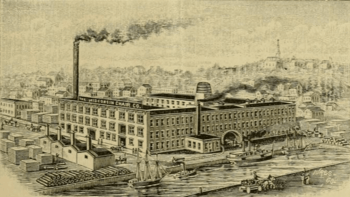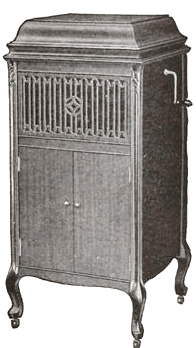Wisconsin Chair Company facts for kids
The Wisconsin Chair Company made furniture and other wooden items. It operated from the late 1800s to the mid-1900s. Their big factory was very important for the town of Port Washington, Wisconsin for over 50 years. This factory was destroyed two times. First, a huge fire burned it down in 1899. Later, it was torn down in 1959.
Contents
How the Company Started
The company began in 1889. A local jeweler named John Bostwick started it. He was a major investor and eventually owned most of the company. He also became its president.
The first factory built by the Wisconsin Chair Company became the biggest employer in the area. It gave jobs to one-sixth of all workers in Ozaukee County, Wisconsin. Because of the factory, Port Washington's population grew a lot. It went from 1,659 people in 1890 to over 3,000 by 1900.
The Big Fire of 1899
After a few tough years, the Chair Company faced its biggest challenge in 1899. A terrible fire completely destroyed the factory. The fire spread through much of downtown Port Washington. Fire engines from Sheboygan and Milwaukee had to come help. People could see the glow from the fire as far away as Whitefish Bay.
The company showed how strong it was by rebuilding right away. For many years after, it remained the main support of Port Washington's economy. However, this amazing success story eventually ended. Sales and profits became smaller, and production slowed down.
Making Music: Phonographs and Records
Early 20th Century Products
In 1915, the Wisconsin Chair Company started making wooden cabinets for phonographs. These were for Edison's diamond disc players. Soon after, they created a separate company called the United Phonograph Corporation (UPC). This new company made phonograph cabinets for other businesses and for their own brands.
The UPC made several different phonograph brands. These included United, Paramount, Puritan, Vista, and Colonial. They also started a record company called New York Recording Laboratories. This company produced Paramount Records and Puritan Records to help sell their phonographs. The company also made phonographs without a brand name. They sold these to local stores like department stores and music shops. These stores could then add their own brand name or label.
The End of Music Production
Between 1922 and 1924, fewer people were buying phonographs. This was because there were too many on the market, and radio was becoming popular. Because of this, the UPC stopped making most phonographs. Only the Paramount brand continued for a while. The Paramount record label lasted until the early 1930s. The Puritan phonograph production ended around 1922-1923, but its record label lasted until the late 1920s. The Great Depression, a time of great economic hardship, caused the Wisconsin Chair Company to stop making all records.
After the Depression
John Bostwick, the company's founder, passed away in 1935. After his death, Otto Moeser ran Wisconsin Chair. The company almost failed during the Great Depression. It survived partly by making special, high-quality furniture instead of mass-produced items. This furniture was for people who could afford luxury goods.
The company had several special departments. One was called the National School Equipment Co.. This division made chairs and desks for schools. They often did this through contracts with the government. The factory was a union shop. This meant its workers were part of the United Brotherhood of Carpenters and Joiners union.
Company Closure
By 1954, the company had closed its large factory. The factory was old and not very efficient. It was located near the N. Franklin Street business district and partly around the city's inner harbor. The factory building was later torn down in 1959.
Today, there is a historic plaque in the area where the factory once stood. It tells the story of the big fire in 1899.
Images for kids





